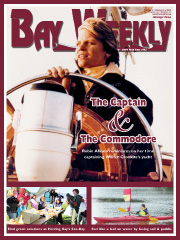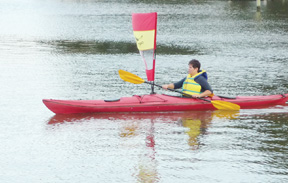
Volume XVII, Issue 41 # October 8 - October 14, 2009
|
 |
The Fusion of Sail and Paddle
Feel what it’s like to be a leaf on the water
|
|
by Jane Elkin
For a duck’s eye view of the water, nothing comes close to bobbing on the waves in a kayak, your whole body attuned to the slightest ripple, current or shift in the breeze. But when that breeze really starts to blow, wouldn’t it be nice to have a sail? You can.
Kayak sailing has its limitations, but it’s rewarding enough that I never launch without my sail at the ready. In light winds, its silent cruise is ideal for a serene break from paddling or a stealthy sneak upon wildlife. In high winds, it’s a white-knuckled, white-water ride that tests both balance and courage. In any wind, there is nothing like it to attract attention.
Hybrid water sports like kayak sailing, canoe sailing and kayak kiting have been growing in popularity for a decade, their names suggesting that imagination is the only limit to enhancing thrills and spills on the water.
A Leaf on the Water
As human travel goes, this is like being a leaf on the water. Most kayak sails are a variant of the Viking-inspired downwind sailing rig, typically with a collapsible V-shaped frame and a clear plastic window. They are designed for following breezes or broad-reach sailing in which the paddle acts as a rudder. The point of sail is controlled either by hand or with a trimming line, depending on the location of the sail mount, which can be either at the bow or the cockpit.
My five-year-old Spirit Sail, an early model, has a mount screwed into the hull just in front of the cockpit. The maker provides strap-on models as well, which let you avoid drilling into your hull. Alternately, a bow-mounted model such as the Pacific Action sail offers a steadier ride and is easier to steer.
Words to the Wise
Raising and lowering a kayak sail can be tricky, depending on wind speed and design. The Spirit Sail mount has notches that lock the sail in place at 30-degree increments around the clock. To deploy the sail, the boat must be positioned stern to the wind. A sea anchor can be helpful here. Once the sail is nestled into the mount, it is rotated to catch the wind. Getting it to lock in place can be tricky in a stiff breeze. At above 12 knots, it can be virtually impossible to yank the sail out of the mount once you get moving, so hurtling toward a sandy shore for a crash landing is the only safe option.
Given that these conversion sails are forcing the boat to do something it wasn’t designed to do, the quality of the ride varies depending on wind speed and direction and on your ability to catch the breeze without compromising stability. Also, if your boat has a tendency to turn into the wind, weathercocking will be even more pronounced under sail, thus requiring almost constant ruddering to maintain a steady course. Dragging the paddle as a rudder slows the boat down.
Capsizing is a real possibility in high winds or lateral gusts, particularly for the novice sailor in a sea kayak. Leaning slightly into the wind and skimming the flat of the paddle across the surface of the water makes it act a bit like a pontoon. If you lean too much, though, or if the wind luffs, you will probably be going for a swim.
Embracing the Possibilities
To avoid capsizing, you may want to invest in a Polynesian-inspired outrigger kit with a traditional-masted sail capable of navigating in any direction. Outriggers are to kayaks what training wheels are to a bike.
There are other ways to capture wind power on the water. Got a canoe? That can be altered, too, with masted sails, outriggers or side dagger boards that dip into the water as the boat heels. Fancy the adventure of a parafoils kite? Kayakers and canoers are embracing them with exciting results.
See these sails in action online at www.youtube.com. Enter the following video titles: Sea Kayak Sailing, Wind Paddle Kayak Sail Video, Kite Yakkin and Canoe Sailing Thrills. Seeing is converting.
